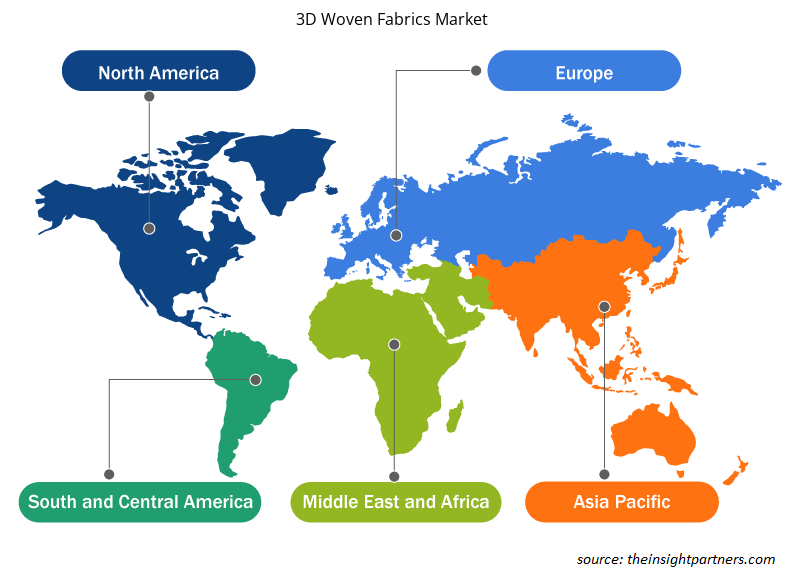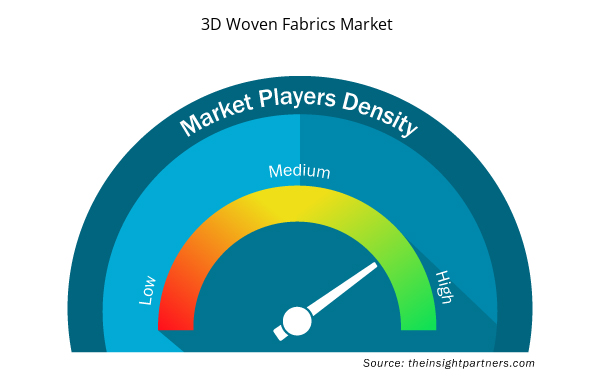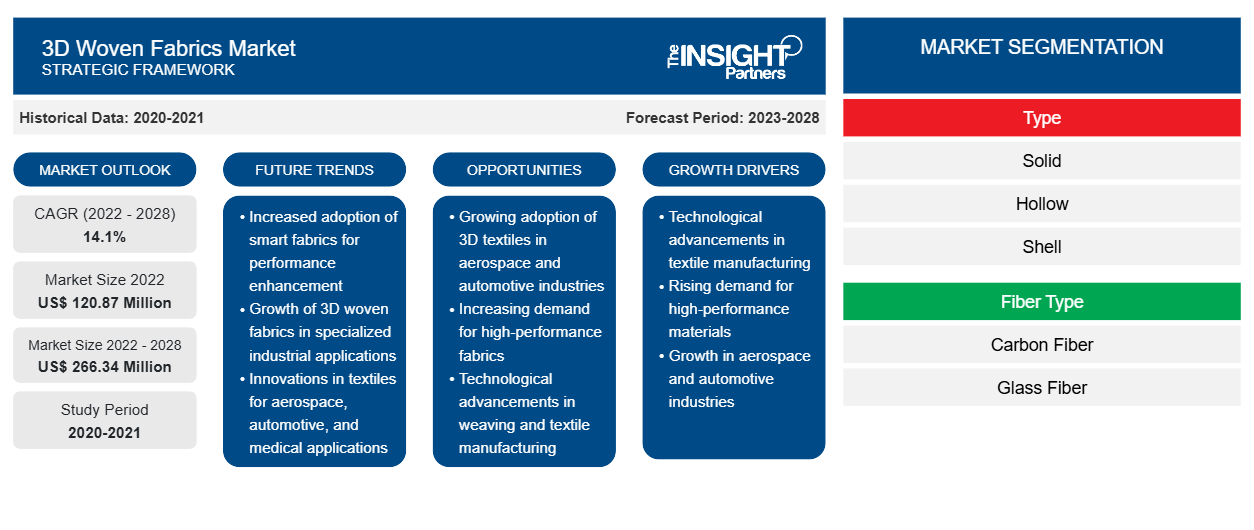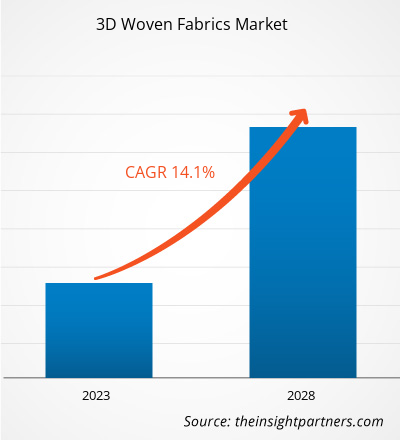[Rapporto di ricerca] Si prevede che il mercato dei tessuti intrecciati 3D crescerà da 120,87 milioni di dollari nel 2022 a 266,34 milioni di dollari entro il 2028; si stima che crescerà a un CAGR del 14,1% dal 2022 al 2028.
I tessuti 3D sono leggeri rispetto alla maggior parte dei legni e dei metalli. La proprietà di leggerezza dei tessuti 3D rende il loro utilizzo importante negli aerei e nelle automobili, dove un peso inferiore offre una migliore efficienza nei consumi. Oggigiorno, i progettisti di aerei sono molto preoccupati per il peso, poiché ridurre il peso di un velivolo riduce la quantità di carburante di cui ha bisogno e aumenta la velocità che può raggiungere. Inoltre, i tessuti 3D resistono ai danni causati dalle intemperie e dalle sostanze chimiche aggressive. Possono essere modellati in forme complicate più facilmente rispetto alla maggior parte degli altri materiali.
Nel 2022, l'Europa ha detenuto la quota di fatturato del mercato dei tessuti 3D più grande del mercato globale dei tessuti 3D. La domanda di tessuti 3D in Europa è in aumento a causa dell'aumento delle attività di ricerca e sviluppo rispetto all'utilizzo di tessuti 3D in settori di utilizzo finale come aeromobili, automotive, edilizia e costruzioni e molti altri. I tessuti 3D in Europa hanno il potenziale per creare opportunità di business, esportazione e applicazioni di produzione avanzate per i settori aerospaziale e automobilistico nella regione. Ciò ha portato a un rapido aumento della popolarità dei tessuti 3D in Europa. Secondo la Commissione europea, l'Unione europea ha investito circa 103 miliardi di dollari nel programma di finanziamento per la ricerca e l'innovazione, Horizon 2021, dal 2021 al 2027. Ha comportato finanziamenti per lo sviluppo di tessuti avanzati utilizzati nei settori dei trasporti e dell'aeronautica. Tutti questi fattori contribuiscono positivamente alla crescita del mercato dei tessuti 3D nella regione.
Personalizza questo report in base alle tue esigenze
Riceverai la personalizzazione gratuita di qualsiasi report, comprese parti di questo report, o analisi a livello nazionale, pacchetto dati Excel, oltre a usufruire di grandi offerte e sconti per start-up e università
- Scopri le principali tendenze di mercato in questo rapporto.Questo campione GRATUITO includerà analisi di dati che spaziano dalle tendenze di mercato alle stime e alle previsioni.
Impatto della pandemia di COVID-19 sul mercato dei tessuti 3D
Settori come l'automotive, l'aerospaziale, l'edilizia e le costruzioni, la difesa e l'esercito hanno contribuito in modo significativo alla domanda di tessuti 3D. Nel 2020, questi settori hanno dovuto rallentare le loro attività a causa delle interruzioni nella catena del valore causate dalla chiusura dei confini nazionali e internazionali. La carenza di manodopera ha comportato la decelerazione delle operazioni di produzione e distribuzione di tessuti 3D. Le interruzioni nella catena di fornitura globale e la chiusura degli impianti di produzione di resina hanno portato a un forte aumento dei prezzi dei tessuti 3D. I blocchi imposti da diversi paesi nel 2020 hanno ostacolato la capacità dei settori di mantenere i livelli di inventario. Inoltre, le misure sanitarie e altre precauzioni COVID-19 hanno ridotto significativamente la capacità produttiva, creando una carenza di inventario di tessuti 3D. Tuttavia, nel 2021, il mercato globale ha iniziato a riprendersi dalle perdite subite nel 2020, poiché i governi di diversi paesi hanno annunciato un allentamento delle restrizioni sociali. Inoltre, l'aumento dei tassi di vaccinazione ha contribuito a migliorare le condizioni generali in diversi paesi, il che ha portato ad ambienti favorevoli al progresso industriale e commerciale. Inoltre, le crescenti capacità produttive nell'industria automobilistica e in altri settori in Europa e Nord America hanno portato a un aumento della domanda di tessuti 3D nel 2021.
Approfondimenti di mercato
Crescente domanda di tessuti 3D nel settore automobilistico e aeronautico
I materiali avanzati sono essenziali per aumentare il risparmio di carburante delle automobili moderne, garantendo al contempo sicurezza e prestazioni. La sostituzione di componenti in ghisa e acciaio tradizionale con materiali leggeri come i tessuti 3D ad alta resistenza riduce il peso della carrozzeria e del telaio di un veicolo, riducendo così il consumo di carburante di un veicolo. Inoltre, i tessuti 3D sono adatti per la produzione di componenti interni non strutturali, schienali dei sedili, rivestimenti del padiglione, pannelli interni e cruscotti. L'utilizzo di compositi rinforzati con fibre naturali sta aumentando nelle applicazioni aeronautiche a causa di leggi e regolamenti che costringono i produttori a utilizzare materiali sostenibili e riciclati per produrre veicoli leggeri ed efficienti in termini di carburante. Inoltre, i produttori di aeromobili stanno compiendo sforzi per ingrandire le strutture termoplastiche primarie nei jet aziendali e negli aerei commerciali. Sono stati i primi ad adottare termoplastiche rinforzate con fibre lunghe.
Tipo Informazioni
In base al tipo, il mercato globale dei tessuti 3D è segmentato in solido, cavo, a guscio e nodale. La quota di mercato globale dei tessuti 3D per il segmento solido è stata la più grande nel 2022. Il solido 3D si riferisce ad architetture intrecciate con sezioni trasversali solide in un pannello largo o in una preforma a forma di rete. È una struttura che comprende sezioni integrate a più pareti nelle direzioni della larghezza e dello spessore del tessuto, definendo una forma trasversale senza alcuna apertura a tunnel nella direzione della lunghezza del tessuto. Il solido 3D è costituito da interblocchi multistrato, ortogonali e angolari. L'ortogonale si basa su filati dritti. I filati di ordito e trama vengono utilizzati per gestire lo spessore del tessuto. Questa struttura ha una frazione di volume maggiore rispetto ad altre. L'interblocco angolare si basa su strati individuali. Ogni strato è diverso dall'altro. Le strutture solide 3D vanno da due a quattro strati. Si prevede che il segmento solido crescerà in modo significativo e rappresenterà la crescita delle dimensioni del mercato dei tessuti 3D.
I principali attori che operano nel mercato globale dei tessuti 3D includono Textum OPCO LLC, Tex Tech Industries Inc, Sigmatex (UK) Ltd, 3D Woven SaRL, Tantra Composite Technologies Pvt Ltd, U-Long High Tech Textile Co Ltd, TEAM Inc, Changzhou Bolong Three Dimensional Composites Co Ltd, Topweaving New Material Tech Co Ltd e China Beihai Fiberglass Co Ltd. Gli attori che operano nel mercato globale dei tessuti 3D si concentrano sulla fornitura di prodotti di alta qualità per soddisfare la domanda dei clienti. Si stanno inoltre concentrando su strategie quali investimenti in attività di ricerca e sviluppo e lanci di nuovi prodotti.
Approfondimenti regionali sul mercato dei tessuti 3D
Le tendenze regionali e i fattori che influenzano il mercato dei tessuti 3D durante il periodo di previsione sono stati ampiamente spiegati dagli analisti di Insight Partners. Questa sezione discute anche i segmenti e la geografia del mercato dei tessuti 3D in Nord America, Europa, Asia Pacifico, Medio Oriente e Africa e America meridionale e centrale.

- Ottieni i dati specifici regionali per il mercato dei tessuti 3D
Ambito del rapporto di mercato sui tessuti 3D
| Attributo del report | Dettagli |
|---|---|
| Dimensioni del mercato nel 2022 | 120,87 milioni di dollari USA |
| Dimensioni del mercato entro il 2028 | 266,34 milioni di dollari USA |
| CAGR globale (2022 - 2028) | 14,1% |
| Dati storici | 2020-2021 |
| Periodo di previsione | 2023-2028 |
| Segmenti coperti | Per tipo
|
| Regioni e Paesi coperti | America del Nord
|
| Leader di mercato e profili aziendali chiave |
|
Densità dei player del mercato dei tessuti 3D: comprendere il suo impatto sulle dinamiche aziendali
Il mercato dei tessuti 3D sta crescendo rapidamente, spinto dalla crescente domanda degli utenti finali dovuta a fattori quali l'evoluzione delle preferenze dei consumatori, i progressi tecnologici e una maggiore consapevolezza dei vantaggi del prodotto. Con l'aumento della domanda, le aziende stanno ampliando le loro offerte, innovando per soddisfare le esigenze dei consumatori e capitalizzando sulle tendenze emergenti, il che alimenta ulteriormente la crescita del mercato.
La densità degli operatori di mercato si riferisce alla distribuzione di aziende o società che operano in un particolare mercato o settore. Indica quanti concorrenti (operatori di mercato) sono presenti in un dato spazio di mercato in relazione alle sue dimensioni o al valore di mercato totale.
Le principali aziende che operano nel mercato dei tessuti 3D sono:
- Testo OPCO LLC
- Tex Tech Industries Inc
- Sigmatex (Regno Unito) Ltd
- Tessitura 3D SaRL
- Tecnologie composite Tantra Pvt Ltd
Disclaimer : le aziende elencate sopra non sono classificate secondo un ordine particolare.

- Ottieni una panoramica dei principali attori del mercato dei tessuti 3D
Segnala i riflettori
- Tendenze industriali progressive nel mercato dei tessuti 3D per aiutare gli operatori a sviluppare strategie efficaci a lungo termine
- Strategie di crescita aziendale adottate dai mercati sviluppati e in via di sviluppo
- Analisi quantitativa del mercato dei tessuti 3D dal 2020 al 2028
- Stima della domanda globale di tessuti 3D
- Analisi delle cinque forze di Porter per illustrare l'efficacia degli acquirenti e dei fornitori che operano nel settore
- Sviluppi recenti per comprendere lo scenario competitivo del mercato
- Tendenze e prospettive di mercato, nonché fattori che guidano e frenano la crescita del mercato dei tessuti 3D
- Assistenza nel processo decisionale evidenziando le strategie di mercato che sostengono l'interesse commerciale, portando alla crescita del mercato
- Le dimensioni del mercato dei tessuti 3D in vari nodi
- Panoramica dettagliata e segmentazione del mercato, nonché dinamiche del settore dei tessuti 3D
- Le dimensioni del mercato dei tessuti 3D in varie regioni con promettenti opportunità di crescita
Mercato globale dei tessuti 3D
In base al tipo, il mercato dei tessuti 3D è segmentato in solido, cavo, a guscio e nodale. In base al tipo di fibra, il mercato globale dei tessuti 3D è segmentato in fibra di carbonio , fibra di vetro e altre. In base all'applicazione, il mercato dei tessuti 3D è segmentato in balistica, aeromobili, trasporti, edilizia e costruzioni e altre.
Profili aziendali
- Testo OPCO LLC
- Tex Tech Industries Inc
- Sigmatex (Regno Unito) Ltd
- Tessitura 3D SaRL
- Tecnologie composite Tantra Pvt Ltd
- Azienda tessile ad alta tecnologia U-Long Co. Ltd.
- SQUADRA Inc.
- Changzhou Bolong Compositi tridimensionali Co Ltd
- Tessitura superiore Nuovo materiale Tech Co Ltd
- Cina Beihai Fiberglass Co Ltd
- Analisi storica (2 anni), anno base, previsione (7 anni) con CAGR
- Analisi PEST e SWOT
- Valore/volume delle dimensioni del mercato - Globale, regionale, nazionale
- Industria e panorama competitivo
- Set di dati Excel



Report Coverage
Revenue forecast, Company Analysis, Industry landscape, Growth factors, and Trends

Segment Covered
This text is related
to segments covered.

Regional Scope
North America, Europe, Asia Pacific, Middle East & Africa, South & Central America

Country Scope
This text is related
to country scope.
Domande frequenti
North America is estimated to register the fastest CAGR in the global 3D woven fabrics market over the forecast period. The region holds extensive growth opportunities for the 3D weaving fabrics market owing to the growing utilization of advanced textiles such as 3D woven fabrics in end-use industries such as aerospace, transportation, building and construction, and aircraft.
The global 3D woven fabrics market is primarily driven by the increasing demand for 3D woven fabrics from the aircraft industry and the growing focus on eco-friendly and sustainable products.
The carbon fiber segment held the largest share of the global 3D woven fabrics market in 2022. Carbon fibers are extremely stiff, strong, and light and are used to create excellent building materials. The major properties of carbon fibers are self-lubricity, heat resistance, tensile strength, and high elastic modulus.
Major players operating in the global 3D woven fabrics market include Textum OPCO LLC, Tex Tech Industries Inc, Sigmatex (UK) Ltd, 3D Weaving SaRL, Tantra Composite Technologies Pvt Ltd, U-Long High Tech Textile Co Ltd, TEAM Inc, Changzhou Bolong Three Dimensional Composites Co Ltd, Topweaving New Material Tech Co Ltd, and China Beihai Fiberglass Co Ltd.
The solid segment held the largest share of the global 3D woven fabrics market in 2022. 3D solid refers to woven architectures with solid cross-sections either in a broad panel or net-shaped preform. The structural strength of solid 3D woven fabrics offers an extensive range of applications for the production of advanced composites.
In 2022, Europe held the largest share of the global 3D woven fabrics market. The rise in R&D activities to develop 3D woven fabrics in Europe has the potential to create opportunities for business, export, and advanced manufacturing applications in the aerospace and automotive industries.
Trends and growth analysis reports related to Chemicals and Materials : READ MORE..
The List of Companies - 3D Woven Fabrics Market
- Textum OPCO LLC
- Tex Tech Industries Inc
- Sigmatex (UK) Ltd
- 3D Weaving SaRL
- Tantra Composite Technologies Pvt Ltd
- U-Long High Tech Textile Co Ltd
- TEAM Inc
- Changzhou Bolong Three Dimensional Composites Co Ltd
- Topweaving New Material Tech Co Ltd
- China Beihai Fiberglass Co Ltd.
The Insight Partners performs research in 4 major stages: Data Collection & Secondary Research, Primary Research, Data Analysis and Data Triangulation & Final Review.
- Data Collection and Secondary Research:
As a market research and consulting firm operating from a decade, we have published and advised several client across the globe. First step for any study will start with an assessment of currently available data and insights from existing reports. Further, historical and current market information is collected from Investor Presentations, Annual Reports, SEC Filings, etc., and other information related to company’s performance and market positioning are gathered from Paid Databases (Factiva, Hoovers, and Reuters) and various other publications available in public domain.
Several associations trade associates, technical forums, institutes, societies and organization are accessed to gain technical as well as market related insights through their publications such as research papers, blogs and press releases related to the studies are referred to get cues about the market. Further, white papers, journals, magazines, and other news articles published in last 3 years are scrutinized and analyzed to understand the current market trends.
- Primary Research:
The primarily interview analysis comprise of data obtained from industry participants interview and answers to survey questions gathered by in-house primary team.
For primary research, interviews are conducted with industry experts/CEOs/Marketing Managers/VPs/Subject Matter Experts from both demand and supply side to get a 360-degree view of the market. The primary team conducts several interviews based on the complexity of the markets to understand the various market trends and dynamics which makes research more credible and precise.
A typical research interview fulfils the following functions:
- Provides first-hand information on the market size, market trends, growth trends, competitive landscape, and outlook
- Validates and strengthens in-house secondary research findings
- Develops the analysis team’s expertise and market understanding
Primary research involves email interactions and telephone interviews for each market, category, segment, and sub-segment across geographies. The participants who typically take part in such a process include, but are not limited to:
- Industry participants: VPs, business development managers, market intelligence managers and national sales managers
- Outside experts: Valuation experts, research analysts and key opinion leaders specializing in the electronics and semiconductor industry.
Below is the breakup of our primary respondents by company, designation, and region:

Once we receive the confirmation from primary research sources or primary respondents, we finalize the base year market estimation and forecast the data as per the macroeconomic and microeconomic factors assessed during data collection.
- Data Analysis:
Once data is validated through both secondary as well as primary respondents, we finalize the market estimations by hypothesis formulation and factor analysis at regional and country level.
- Macro-Economic Factor Analysis:
We analyse macroeconomic indicators such the gross domestic product (GDP), increase in the demand for goods and services across industries, technological advancement, regional economic growth, governmental policies, the influence of COVID-19, PEST analysis, and other aspects. This analysis aids in setting benchmarks for various nations/regions and approximating market splits. Additionally, the general trend of the aforementioned components aid in determining the market's development possibilities.
- Country Level Data:
Various factors that are especially aligned to the country are taken into account to determine the market size for a certain area and country, including the presence of vendors, such as headquarters and offices, the country's GDP, demand patterns, and industry growth. To comprehend the market dynamics for the nation, a number of growth variables, inhibitors, application areas, and current market trends are researched. The aforementioned elements aid in determining the country's overall market's growth potential.
- Company Profile:
The “Table of Contents” is formulated by listing and analyzing more than 25 - 30 companies operating in the market ecosystem across geographies. However, we profile only 10 companies as a standard practice in our syndicate reports. These 10 companies comprise leading, emerging, and regional players. Nonetheless, our analysis is not restricted to the 10 listed companies, we also analyze other companies present in the market to develop a holistic view and understand the prevailing trends. The “Company Profiles” section in the report covers key facts, business description, products & services, financial information, SWOT analysis, and key developments. The financial information presented is extracted from the annual reports and official documents of the publicly listed companies. Upon collecting the information for the sections of respective companies, we verify them via various primary sources and then compile the data in respective company profiles. The company level information helps us in deriving the base number as well as in forecasting the market size.
- Developing Base Number:
Aggregation of sales statistics (2020-2022) and macro-economic factor, and other secondary and primary research insights are utilized to arrive at base number and related market shares for 2022. The data gaps are identified in this step and relevant market data is analyzed, collected from paid primary interviews or databases. On finalizing the base year market size, forecasts are developed on the basis of macro-economic, industry and market growth factors and company level analysis.
- Data Triangulation and Final Review:
The market findings and base year market size calculations are validated from supply as well as demand side. Demand side validations are based on macro-economic factor analysis and benchmarks for respective regions and countries. In case of supply side validations, revenues of major companies are estimated (in case not available) based on industry benchmark, approximate number of employees, product portfolio, and primary interviews revenues are gathered. Further revenue from target product/service segment is assessed to avoid overshooting of market statistics. In case of heavy deviations between supply and demand side values, all thes steps are repeated to achieve synchronization.
We follow an iterative model, wherein we share our research findings with Subject Matter Experts (SME’s) and Key Opinion Leaders (KOLs) until consensus view of the market is not formulated – this model negates any drastic deviation in the opinions of experts. Only validated and universally acceptable research findings are quoted in our reports.
We have important check points that we use to validate our research findings – which we call – data triangulation, where we validate the information, we generate from secondary sources with primary interviews and then we re-validate with our internal data bases and Subject matter experts. This comprehensive model enables us to deliver high quality, reliable data in shortest possible time.


 Ottieni un campione gratuito per questo repot
Ottieni un campione gratuito per questo repot